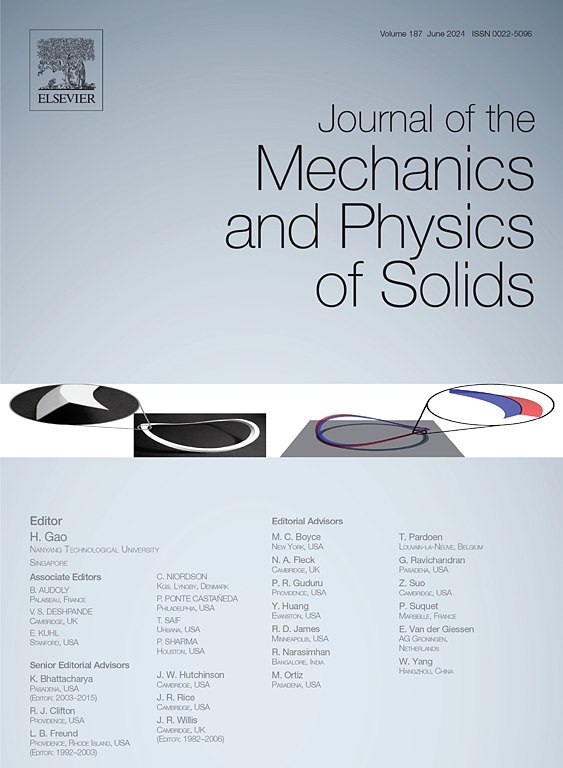A multiscale-multiphysics framework for modeling organ-scale liver regrowth
IF 5
2区 工程技术
Q2 MATERIALS SCIENCE, MULTIDISCIPLINARY
引用次数: 0
Abstract
We present a framework for modeling liver regrowth on the organ scale that is based on three components: (1) a multiscale perfusion model that combines synthetic vascular tree generation with a multi-compartment homogenized flow model, including a homogenization procedure to obtain effective parameters; (2) a poroelastic finite growth model that acts on all compartments and the synthetic vascular tree structure; (3) an evolution equation for the local volumetric growth factor, driven by the homogenized flow rate into the microcirculation as a measure of local hyperperfusion and well-suited for calibration with available data. We apply our modeling framework to a prototypical benchmark and a full-scale patient-specific liver, for which we assume a common surgical cut. Our simulation results demonstrate that our model represents hyperperfusion as a consequence of partial resection and accounts for its reduction towards a homeostatic perfusion state, exhibiting overall regrowth dynamics that correspond well with clinical observations. In addition, our results show that our model also captures local hypoperfusion in the vicinity of orphan vessels, a key requirement for the prediction of ischemia or the preoperative identification of suitable cut patterns.
用于模拟器官尺度肝脏再生的多尺度-多物理场框架
我们提出了一个在器官尺度上模拟肝脏再生的框架,该框架基于三个组成部分:(1)一个多尺度灌注模型,该模型结合了合成血管树生成和多室均质流模型,包括均质过程以获得有效参数;(2)作用于所有室室和合成维管树结构的孔弹性有限生长模型;(3)局部体积生长因子的演化方程,由进入微循环的均质流速驱动,作为局部高灌注的测量,非常适合用现有数据校准。我们将我们的建模框架应用于一个原型基准和一个全尺寸的患者特异性肝脏,我们假设它是一个普通的手术切口。我们的模拟结果表明,我们的模型代表了部分切除导致的过度灌注,并解释了其向稳态灌注状态的减少,显示出与临床观察相符的整体再生动力学。此外,我们的研究结果表明,我们的模型还捕获了孤儿血管附近的局部灌注不足,这是预测缺血或术前识别合适切割模式的关键要求。
本文章由计算机程序翻译,如有差异,请以英文原文为准。
求助全文
约1分钟内获得全文
求助全文
来源期刊
CiteScore
9.80
自引率
9.40%
发文量
276
审稿时长
52 days
期刊介绍:
The aim of Journal of The Mechanics and Physics of Solids is to publish research of the highest quality and of lasting significance on the mechanics of solids. The scope is broad, from fundamental concepts in mechanics to the analysis of novel phenomena and applications. Solids are interpreted broadly to include both hard and soft materials as well as natural and synthetic structures. The approach can be theoretical, experimental or computational.This research activity sits within engineering science and the allied areas of applied mathematics, materials science, bio-mechanics, applied physics, and geophysics.
The Journal was founded in 1952 by Rodney Hill, who was its Editor-in-Chief until 1968. The topics of interest to the Journal evolve with developments in the subject but its basic ethos remains the same: to publish research of the highest quality relating to the mechanics of solids. Thus, emphasis is placed on the development of fundamental concepts of mechanics and novel applications of these concepts based on theoretical, experimental or computational approaches, drawing upon the various branches of engineering science and the allied areas within applied mathematics, materials science, structural engineering, applied physics, and geophysics.
The main purpose of the Journal is to foster scientific understanding of the processes of deformation and mechanical failure of all solid materials, both technological and natural, and the connections between these processes and their underlying physical mechanisms. In this sense, the content of the Journal should reflect the current state of the discipline in analysis, experimental observation, and numerical simulation. In the interest of achieving this goal, authors are encouraged to consider the significance of their contributions for the field of mechanics and the implications of their results, in addition to describing the details of their work.

 求助内容:
求助内容: 应助结果提醒方式:
应助结果提醒方式:


